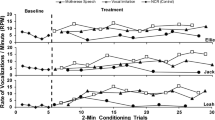Abstract
Many children with autism do not imitate adult vocalizations, an important skill in learning to talk. Pairing adult vocalizations with preferred stimuli has been shown to increase free-operant vocalizations but effects are temporary; thus, direct reinforcement may be necessary to establish durable vocal behaviors. In Experiment 1, directly reinforced echoic responses did not increase following stimulus-stimulus pairings in three children with autism. Similarly, pairings did not increase free-operant vocalizations in Experiment 2, a replication of Miguel et al. (2002). Experiment 3 demonstrated that shaping increased vowel frequency for one participant. Results suggest that variables are yet to be delineated that influence effectiveness of a stimulus-stimulus pairing procedure on vocalization frequency and acquisition of a verbal operant following such pairings.
Similar content being viewed by others
References
Bijou, S. W., & Baer, D. M. (1965). Child development: Vol. 2. Universal stage of infancy. New York: Appleton-Century-Crofts.
Brown, R. (1973). A first language: The early stages. Cambridge, MA: Harvard University Press.
Bzoch, K. R., League, R., & Brown, V. L. (2003). Receptive-expressive emergent language test (3rd ed.}). Austin, TX: Pro-Ed.
Carr, J. E., Nicolson, A. C., & Higbee, T. S. (2000). Evaluation of a brief multiple-stimulus preference assessment in a naturalistic context. Journal of Applied Behavior Analysis, 33, 353–357.
Chomsky, N. (1959). A review of B. F. Skinner’s Verbal Behavior. Language, 35, 26–58.
Dunn, L. M., Dunn, L. M., & Dunn, D. M. (1997). Peabody picture vocabulary test (3rd ed.). Circle Pines, MN: American Guidance Service, Inc.
Fantino, E. (1981). Contiguity, response strength, and the delay-reduction hypothesis. In P. Harzem & J. H. Zeiler, (Eds.), Predictability, correlation, and contiguity (pp. 169–201). New York: John Wiley.
Fisher, W. W., Piazza, C. C., Bowman, L. G., & Amari, A. (1996). Integrating caregiver report with a systematic choice assessment to enhance reinforcer identification. American Journal of Mental Retardation, 101, 15–25.
Frost, L. A., & Bondy, A. S. (1994). The picture exchange communication system. Cherry Hill, NJ: Pyramid Educational Consultants, Inc.
Galensky, T. L., Miltenberger, R. G., Stricker, J. M., & Garlinghouse, M. A. (2001). Functional assessment and treatment of mealtime behavior problems. Journal of Positive Behavior Interventions, 3, 211–224.
Hayes, S. C., Barlow, D. H., & Nelson-Gray, R. O. (1999). The scientist practitioner: Research and accountability in the age of managed care (2nd ed.). Boston: Allyn and Bacon.
International Phonetic Association (1999). Handbook of the international phonetic association: A guide to the use of the International phonetic alphabet. Cambridge, England: Cambridge University Press.
Kaufman, N. R. (1995). Kaufman speech praxis test. Detroit: Wayne State University Press.
Ling, D. (1976). Speech and the hearing impaired child: Theory and practice. Washington, DC: Alexander Graham Bell Association for the Deaf.
Ling, D. (1989). Foundations of spoken language for hearing-impaired children. Washington, DC: Alexander Graham Bell Association for the Deaf.
Lovaas, O. I. (1981). Teaching developmentally disabled children: The me book. Austin, TX: Pro-Ed.
Miguel, C. F., Carr, J. E., & Michael, J. (2002). The effects of a stimulus-stimulus pairing procedure on the vocal behavior of children diagnosed with autism. The Analysis of Verbal Behavior, 18, 3–13.
Moerk, E. L. (1990). Three-term contingency patterns in mother-child verbal interactions during first language acquisition. Journal of the Experimental Analysis of Behavior, 54, 293–305.
Palmer, D. C. (1996). Achieving parity: The role of automatic reinforcement. Journal of the Experimental Analysis of Behavior, 65, 289–290.
Pinker, S. (1994). The language instinct: How the mind creates language. New York: William Morrow & Company.
Schlinger, H. D., Jr. (1995). A behavior analytic view of child development. New York: Plenum Press.
Skinner, B. F. (1957). Verbal behavior. New York: Appleton-Century-Crofts.
Smith, R., Michael, J., & Sundberg, M. L. (1996). Automatic reinforcement and automatic punishment in infant vocal behavior. The Analysis of Verbal Behavior, 13, 39–48.
Sundberg, M. L., Michael, J., Partington, J. W., & Sundberg, C. A. (1996). The role of automatic reinforcement in early language acquisition. The Analysis of Verbal Behavior, 13, 21–37.
Sundberg, M. L., & Partington, J. W. (1998). Teaching language to children with autism or other developmental disabilities. Pleasant Hill, CA: Behavior Analysts, Inc.
Vaughan, M. E., & Michael, J. (1982). Automatic reinforcement: An important but ignored concept. Behaviorism, 10, 217–227.
Yoon, S., & Bennett, G. M. (2000). Effects of a stimulus-stimulus pairing procedure on conditioning vocal sounds as reinforcers. The Analysis of Verbal Behavior, 17, 75–88.
Author information
Authors and Affiliations
Corresponding author
Additional information
We would like to express our appreciation to Scott Gaynor for his conceptual contributions to this paper. Also, we thank our research assistants, Christopher Gioia, Breanne Armstrong, and Katie McCloud, for their help with this study.
Rights and permissions
About this article
Cite this article
Esch, B.E., Carr, J.E. & Michael, J. Evaluating Stimulus-Stimulus Pairing and Direct Reinforcement in the Establishment of an Echoic Repertoire of Children Diagnosed with Autism. Analysis Verbal Behav 21, 43–58 (2005). https://doi.org/10.1007/BF03393009
Published:
Issue Date:
DOI: https://doi.org/10.1007/BF03393009




